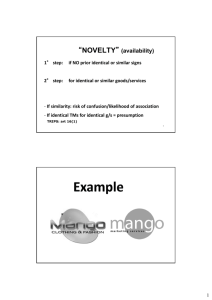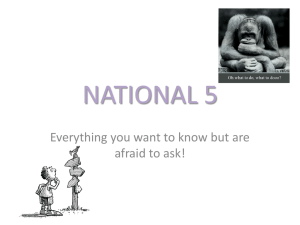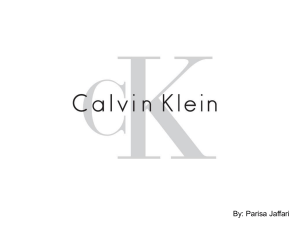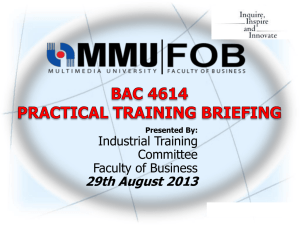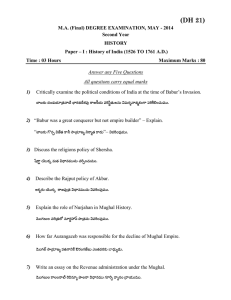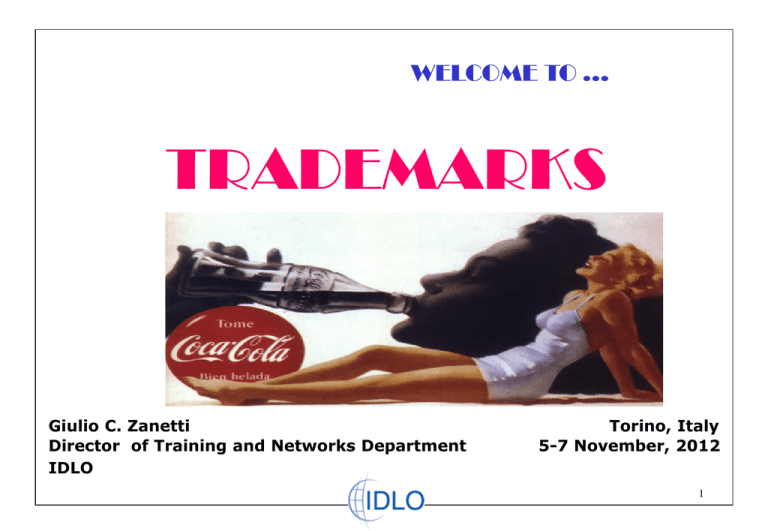
WELCOME TO ...
TRADEMARKS
Giulio C. Zanetti
Director of Training and Networks Department
IDLO
Torino, Italy
5-7 November, 2012
1
What is a trade mark?
Any visual sign capable of
distinguishing the
goods/services of one
natural person/legal entity
... from others, including ….
TRIPS: art 15
2
MARKS
MARKS
Trademarks
Service Marks
PRINCIPLE OF SPECIFICITY
3
INTERESTS TO BE CONSIDERED
1) The applicant (TM owner)
2) The competitors
3) The public / consumers
4
examples
WORDS (word marks)
Adidas Starbucks Whirlpool Nestlé Volkswagen
Sony Harley Davidson Philips Just Do It Orange
Siemens
Lays
Red Bull
Gatorade Coca Cola
Rolex
Microsoft
Shell
PepsiCo
Java
Ford
Vodafone JVC
Apple
RayBan
Zippo
Levis
Bic
MGM Petronor Herbalife EMI Sellotape Pfeizer
5
examples
LOGOS (figurative marks)
6
examples
OBJECTS (3-D marks)
7
examples
COLOURS OR COMBINATIONS (colour marks)
8
examples
SOUNDS and SMELL marks
(Tarzan yell)
(Popping)
(Sound of tennis balls being hit)
9
CHARACTERISTICS
+ Distinctiveness
+ “Novelty” (availability)
- NOT Misleading, Descriptive, Generic
Contrary to public order/morality ...
10
DISTINCTIVENESS
Assessed in Relation with:
Goods/Services (Principle of Specificity)
Laws/Jurisprudence
Average Consumer
of country
concerned
(Principle of
Territoriality)
11
Want to increase the distinctiveness?
1) Special script
2) Special colour (colour claim/limitation)
3) Logo (non descriptive)
4) G/S limitation
12
DISTINCTIVENESS (cont.)
>
Vulgarization
> Secondary
you prove it?
Meaning ...
how can
13
Hells Angels
Motorcycle
Corporation
v.
Amazon.com
14
“NOVELTY” (availability)
1)
Prior identical or similar signs
2) For identical or similar goods/services
-
If similarity: risk of confusion/likelihood of
association
- If identical TMs for identical g/s = presumption
TRIPS: art 16(1)
15
SIMILARITY b/w signs
3 criteria:
1) Conceptual similarity
2) Visual similarity
3) Phonetic similarity
16
VISUAL SIMILARITY
17
CONCEPTUAL similarity
DOUGHBOY
v.
18
CONCEPTUAL similarity
THE SOUTH BUTT
19
Similarity?
20
Similarity?
21
Similarity?
22
CONCEPTUAL / PHONETIC /
VISUAL similarity
23
SIMILARITY b/w goods/services
Criteria:
1) Same class? … not necessarily
2) Same purpose
3) Same public (consumers)
4) Same channels of distribution
5) “Cross-substitutability”
24
LEGAL ARGUMENTS
1) the “CORE PART” of the mark
2) the “OVERALL IMPRESSION” of the
mark
25
The “Ciao Napoli”
case
“Ciao Napoli” (cont.)
Community application
- food
- drinks
- Restaurants, bars
(CIAO Srl, Napoli)
il caso “Ciao Napoli” (cont)
Prior CTM
- food
- drinks
- Restaurants, bars
CIAO RISTORANTE
(Autogrill SpA)
“Ciao Napoli” (cont.)
Examiner
1. “CIAO” is not distinctive as it is a common way of greeting
(in Italy)
2. The presence of “ciao”in both marks does not imply
confusion
3. The design of the marks is different.
4. The consumer CAN distinguish them
5. Therefore: no risk of confusion
“Ciao Napoli” (cont.)
Board of Appeal
1. The fact that “ciao” is a typical way to greet in Italy is not
relevent to its distinctivenenss
2. Distinctivenenss must be analyzed only vis-à-vis the
products and services.
3. “Ciao” is not a common word to distinguish food or
restaurants
4. Therefore: it’s distinctive ….. Therefore ….
“Ciao Napoli” (cont)
5. “Ciao” is the core part of both marks
6. The marks are therefore SIMILAR
7. The products and services are IDENTICAL
8. Therefore: risk of confusion in Italy (and elsewhere)
9. The application is thus: rejected
Decision R 36/2004-1 of July 20 2004
The “Roberto Cavalli”
case
“Roberto Cavalli” (cont)
“Roberto Cavalli” (cont)
CTM application
- Clothing
- Leather products
- Glasses
(CP3 Srl, Sesto Fiorentino)
“Roberto Cavalli” (cont)
Prior CTM
- Clothing
- Leather products
- Glasses
(Sig. Roberto Cavalli)
“Roberto Cavalli” (cont)
Examiner
1. The core part of the TMs is respectively:
ROBERTO
and
CAVALLI
2. The 2 names are different
3. The surname is more important than the name
4. Both are written in common characters
5. Therefore no risk of confusion
6. …even if the products are identical
“Roberto Cavalli” (cont)
Board of Appeal
1. “Very suspicious” the similarity in the grafic style of the
letters: ‘b’
‘e’
‘r’
2. Both are in lower cases
3. The letter ‘c’ (again in lower cases!) may allude to
‘cavalli’
4. the visul impression is very similar, and
… too many coincidences!!!!
“Roberto Cavalli” (cont)
5. The graphic style of a mark in the fashion industry is
… key
6. Even the absence of the full surname does not
eliminate the similarity
7. Risk of association
8. The applcation is thus: rejected
Decision R 533/2005-1 of April 26 2006
“Roberto Cavalli” (cont)
Let’s think together …
1. The graphic aspect of a mark can in some cases
determine similarity even though the marks are
conceptually and phonetially different.
2. … especially in the fashion sector where the average
consumer is particularly attentive to the look (of the
products and of the marks)
3. Example of di “risk of association”
The “Pepe Jeans” case
“Pepe Jeans” (cont)
“Pepe Jeans” (cont)
CTM application
- Clothing
- Leather products
- Parfumes
(José Jiménez Arellano SA, Madrid)
“Pepe Jeans” (cont)
Denim de Luxe
by Pepe Jeans
prior marks
Pepe Jeans Portobello
Pepe 2 XL
Khaki
by Pepe Jeans
Pepe F4
Pepe Jeans M2
Pepe Jeans
PEPE
(Pepe Jeans Company)
Pepe Jeans 73
NB: in Spain
“Pepe Jeans” (cont)
Opponent
1. “Pepe” is the core part of both marks (“Jeans” = generic)
2. All marks“Pepe” represent a‘family’. Consumers may
think that “Pepe Arellano” belongs to the same family
3. Marks “Pepe” are well known
4. Risk of confusion
“Pepe Jeans” (cont)
Examiner
1. The marks “Pepe Jeans” are very well known in Spain
2. They all belong to the same “family”
3. The element “Pepe” makes “Pepe Arellano” similarly
confusing with “Pepe Jeans”
4. Opposition accepted, mark “Pepe Arellano” rejected
“Pepe Jeans” (cont)
Boar d of Appeal
1. The marks are NOT confusingly similar as:
-
The role of “Pepe” in different i the 2 marks
It is dominant in “Pepe Jeans”, secondary in “Pepe Arellano”
-
The core part of “Pepe Arellano” is “Arellano” (the
surname)
“Pepe Jeans” (cont)
2. There is no “family” of marks
- the public must already know the
family
- “family” must be on the market and not only on the register
- In reality the public only knows …
“Pepe Jeans” (cont)
3. No confusion because:
- Different structure of the marks:
“Pepe” + generic name
/ “Pepe” + surname
- Different graphic style:
- A careful consumer would not believe that the 2 marks
belong to the same “family”
“Pepe Jeans” (cont)
4. There is no taking advantage of the well known character of
the prior mark as the 2 marks are NOT similar
Decision R 117/2006-1 of february 15 2007
A MARK MUST NOT BE
DESCRIPTIVE
(in the broad sense)
GENERIC
MISLEADING / deceptive
CONTARY TO PUBLIC ORDER
andMORALITY
50
The “Garum” case
“Garum” (cont)
CTM applcation
Fish preserves
(Compagnie Générale de Diététique, France)
“Garum”
Plinio : “sauce beased on rotten fish”
Garum =
Delicious seasoning based on fermented fish, commomly
used by the ancient romans
“Garum” (cont)
Board of Appeal
1. generic name for seasonings during the time of the ancient
romans
2. cited by “Larousse Gastronomique” dictionary
3. term unknown to the wide public but ….. known to the
experts of the sector
4. generic mark = refused
Decision R 1401/2005-1 of september 7 2006
The “Screw You” case
“Screw You” (cont)
“Screw You” (cont)
•
•
•
•
•
•
Sun glasses
condoms
Artificial breasts, erotic toys
clothing, shoes
Sport articles
Alcoholic beverages
What do you think?
(Mr Kenneth Jebaraj, known as “Screw You”,
London)
“Screw You” (cont)
Board of Appeal
1. refused for:
sun glasses, clothing, sport items and beverages
2. granted for :
all items relating to sex
“Screw You” (cont)
A. the expression is highly vulgar in english
B. but you have to determine the level of tolerance of
the public concerned
C. it varies depending on the type of product (and type
of consumer)
“Screw You” (cont)
A. For products meant for mass market (large public) the
level is lower the mark is vulgar
B. For products relating to sexuality the mark is valid
Decision R 495/2005-G of 6 July2006
Contrary to public order / morality
For restaurants
What do you think?
61
Art 6 ter
MS will refuse/invalidate TMs = to:
- Armorial bearings, flags, emblems, other signs
of STATES
- Armorial bearings, flags, emblems,
abbreviations, names of INT. INTERGOVT.
ORG.
COMMUNICATION to other MS through WIPO
-
Facultative for States
Obligatory for IGOs
12 m. for objections
62
“Special” marks
1) Well-known marks
2) Geographical marks
3) 3-D marks
4) Collective/Certification marks
5) Names and surnames
6) Letters and numbers
63
Well known marks
- What is a W-K mark? (criteria)
- Consequences:
Exception to 2 principles !!!
a) if not registered = for identical/similar g/s
b) if registered = for identical + similar +
dissimilar g/s
Paris Conv: art 6bis
TRIPS: art 16(2)
64
WELL KNOWN TMs
cont.
65
Similarity?
66
Geographical marks
Bad news!!
67
Marks & GIs: differences
Both distinctive signs, but ....
A. Ownership (not to identify g/s produced by one or
more enterprises, but to identify goods originating from
a particular geo. area)
B. Compliance with quality standards
Ergo: all enterprises operating in that geo. area in accordance
with standards can use G.I.
68
The “Lego” case
“Lego” (cont)
“Lego” (cont)
Board of Appeal
The little brick was protected
as a patent (expired)
= proof that it’s a
functional shape
3-D marks
Only if shape is:
1) distinctive (often after use)
2) not necessary
3) not a technical result
72
Collective / Certification marks
COLLECTIVE TMs: signes used to distinguish the g/s
of the members of an association (+Regulation of
Use) from those of other undertakings
CERTIFICATION TMs: sign used to indicate that the
g/s in connection with which it is used are certified
by the proprietor of the sign in respect of origin,
materials, mode of manufacture, quality, accuracy or
other characteristics
73
First names and surnames
- Can you use your surname as TM?
- What can you do if someone has a TM = to your
surname?
- Criteria for registering: 1) commonnes of name 2)
No of undertaking engaged in same trade
- Surnames with meaning?
- Variations?
- Single first names: for services? for goods?
- Full names?
74
... AND MY NAME?
75
LETTERS and NUMBERS
76
The life of a MARK
Duration:
7 years (TRIPS), but:
10 years … for ever!
…………….. Why?
Renewal
Priority: 6 months
77
NORMATIVE FRAMEWORK
National Legislation
Paris Convention
TRIPs
Madrid Agr./Protocol, CTM, Bagui Agr. / Bajul
Protocol
Nice Classification
TLT / Singapore treaty
78
ENFORCEMENT
Condicio sine qua non for existence of an IP system
Procedures
Effective
Fair
Expeditious
Constitute a deterrent
Not complicated
Not costly
79
Tips
Avoid Litigation!!!
• “Create around” or License
• Be your own policeman!
• Other “friendly” agreements
• Cease and Desist letter
• Negotiate an out-of-court attempt
80
Action Before National IP Office
•Decision of examiner can be appealed
with:
• Appeals Board (administrative)
• Court of First Instance
• Court of Appeal
• Opposition: 2-3 months
81
Action Before Court
Civil Action
WRIT by IP Holder:
• Statement of own right
Certificate
Copy of
• Alleged infringement
• Evidence
• Remedy Sought
82
CANCELLATION FOR
LACK OF USE
NO USE:
⇒ Uninterrupted period
⇒ Of at least 3 years
⇒ Without valid reasons
⇒ Total or partial
-Use by another person?
TRIPS: art. 19
83
ACQUIESCENCE
Tolerance for 5 years
(except if bad faith)
coexistence of marks
84
Action Before Court
CANCELLATION
• Contrary to absolute requirements
• Contrary to relative requirements
• Registration in bad faith
• Violates other prior IPR (eg: geo indic., ind. design)
• (Time limit: 5 years from registration date)
85
CRIMINAL ACTIONS
Only for SERIOUS offenses
⇒ TM Counterfeiting
⇒ (Identical TMs)
Knowingly
Right holder (coop. with police)
Action by
Enforcement officers
Custom authorities
86
REQUESTS OF THE PARTIES
1. Plaintiff ⇒ Infringement of own TM
• Injunction (preliminary/final/ex parte)
Lost sales
• Damages
Profit of Infringer
• Destruction
• Declaration of Validity + Infringement
2. Defendant ⇒ Cancellation of TM because not
valid
87
EVIDENCE OF OWNERSHIP OF TM
⇒ Certified Copy of Certificate
Attention to:
Representation of TM
List of goods/services
Date
Name of Proprietor
88
EVIDENCE
• Direct Evidence
vs.
Secondary Evidence
• Documentary Evidence:
Description
+ Source
File History (application/registration, objections
by IP office, arguments, contracts)
Market Surveys/statistics
Photos
Sales Figures
• Real Evidence
• Expert Evidence
• Witnesses
89
BURDEN OF PROOF
RULE: up to the plaintiff
(ownership, similarity,
violation, confusion for the
public)
Exception: identical sign for
identical g/s
90
Legal arguments … most
common
- … 3 legal characteristics + well-known
secondary meaning /vulgarization
- risk of confusion / likeliwood of association
- the “core part” of the mark
-the “overall impression” of the mark
- coexistence between marks
- complex marks (protection of various elements)
91
Thank you!!!
gzanetti@idlo.int
92

